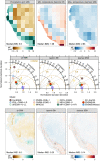High-resolution climate projection dataset based on CMIP6 for Peru and Ecuador: BASD-CMIP6-PE
- PMID: 38182605
- PMCID: PMC10770365
- DOI: 10.1038/s41597-023-02863-z
High-resolution climate projection dataset based on CMIP6 for Peru and Ecuador: BASD-CMIP6-PE
Abstract
Here, we present BASD-CMIP6-PE, a high-resolution (1d, 10 km) climate dataset for Peru and Ecuador based on the bias-adjusted and statistically downscaled CMIP6 climate projections of 10 GCMs. This dataset includes both historical simulations (1850-2014) and future projections (2015-2100) for precipitation and minimum, mean, and maximum temperature under three Shared Socioeconomic Pathways (SSP1-2.6, SSP3-7.0, and SSP5-8.5). The BASD-CMIP6-PE climate data were generated using the trend-preserving Bias Adjustment and Statistical Downscaling (BASD) method. The BASD performance was evaluated using observational data and through hydrological modeling across Peruvian and Ecuadorian river basins in the historical period. Results demonstrated that BASD significantly reduced biases between CMIP6-GCM simulations and observational data, enhancing long-term statistical representations, including mean and extreme values, and seasonal patterns. Furthermore, the hydrological evaluation highlighted the appropriateness of adjusted GCM simulations for simulating streamflow, including mean, low, and high flows. These findings underscore the reliability of BASD-CMIP6-PE in assessing regional climate change impacts on agriculture, water resources, and hydrological extremes.
© 2024. The Author(s).
Conflict of interest statement
The authors declare no competing interests.
Figures








References
-
- Funk C, et al. A global satellite-assisted precipitation climatology. Earth Syst. Sci. Data. 2015;7:275–287. doi: 10.5194/essd-7-275-2015. - DOI
-
- Beck HE, et al. MSWEP: 3-hourly 0.25° global gridded precipitation (1979–2015) by merging gauge, satellite, and reanalysis data. Hydrol. Earth Syst. Sci. 2017;21:589–615. doi: 10.5194/hess-21-589-2017. - DOI
-
- Beck HE, et al. MSWEP V2 Global 3-Hourly 0.1° Precipitation: Methodology and Quantitative Assessment. Bull. Am. Meteorol. Soc. 2019;100:473–500. doi: 10.1175/BAMS-D-17-0138.1. - DOI
-
- Huerta, A., Aybar, C. & Lavado-Casimiro, W. PISCO temperatura v.1.1. SENAMHI - DHI-2018, Lima-Perú. http://iridl.ldeo.columbia.edu/documentation/.pisco/.PISCOt_report.pdf (2018).
Publication types
LinkOut - more resources
Full Text Sources

